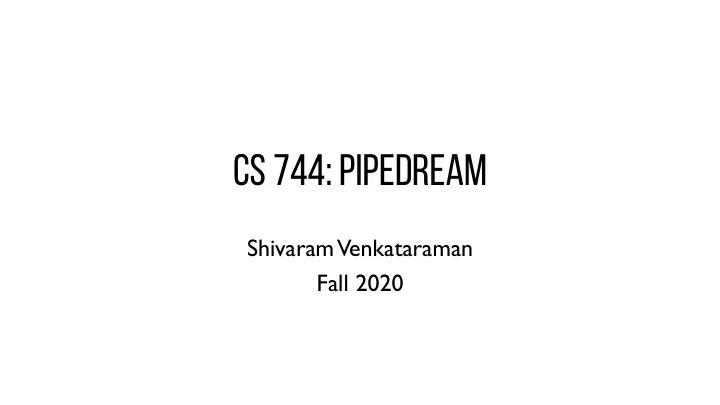

CS 744: PIPEDREAM Shivaram Venkataraman Fall 2020
ADMINISTRIVIA - Assignment 2 is due Oct 5th! - Course project groups due today! - Project proposal aka Introduction (10/16) Introduction Related Work Timeline (with eval plan)
WRITING AN INTRODUCTION 1-2 paras: what is the problem you are solving why is it important (need citations) 1-2 paras: How other people solve and why they fall short 1-2 paras: How do you plan on solving it and why your approach is better 1 para: Anticipated results or what experiments you will use
RELATED WORK, EVAL PLAN Group related work into 2 or 3 buckets (1-2 para per bucket) Explain what the papers / projects do Why are they different / insufficient Eval Plan Describe what datasets, hardware you will use Available: Cloudlab, Google Cloud (~$150), Jetson TX2 etc.
LIMITATIONS OF DATA PARALLEL “fraction of training time spent in communication stalls”
MODEL PARALLEL TRAINING
PIPELINE parallel Advantages?
CHALLENGE 1: WORK PARTITIONING Goal: Balanced stages in the pipeline. Why? Stages can be replicated!
WORK PARITIONING Profiler: computation time for forward, backward size of output activations, gradients (network transfer) size of parameters (memory) Dynamic programming algorithm Intuition: Find optimal partitions within a server, Then find best split across servers using that
CHALLENGE 2: WORK SCHEDULING Traditional data parallel forward iter(i) backward iter(i) forward iter(i+1) … Pipeline parallel: Worker can Forward pass to push to downstream Backward pass to push to upstream
CHALLENGE 2: WORK SCHEDULING Num active batches ~= num_workers / num_replicas_input Schedule one-forward-one-backward (1F1B) Round-robin for replicated stages à same worker for fwd, backward
CHALLENGE 3: EFFECTIVE LEARNING Naïve pipelining Different model versions forward and backward 5
CHALLENGE 3: EFFECTIVE LEARNING Weight stashing Maintain multiple versions of the weights One per active mini-batch Use latest version for forward pass. Retrieve for backward
STALENESS, Memory oVERHEAD How to avoid staleness: Vertical sync Memory overhead Similar to data parallel?
SUMMARY Pipeline parallelism: Combine inter-batch and intra-batch Partitioning: Replication, dynamic programming Scheduling: 1F1B Weight management: Stashing, vertical sync
DISCUSSION https://forms.gle/GdVRuE8rBHH2vPPW6
List two takeaways from the following table Model Name Model Size GPUs PipeDream Speedup over (#Servers x Config DataParallel #GPUs/Server) (Epoch Time) Resnet-50 97MB 4x4 16 1 × 2x8 16 1x VGG-16 528MB 4x4 15-1 5.28x 2x8 15-1 2.98x GNMT -8 1.1GB 3x4 Straight 2.95x 2x8 16 1x
What are some other workload scenarios (e.g. things we discussed for MapReduce or Spark) that could use similar ideas of pipelined parallelism? Develop such one example and its execution
NEXT STEPS Next class: TVM Assignment 2 is out! Course project deadlines Today! (titles, groups) Oct 16 (introductions)
Recommend
More recommend